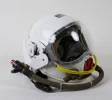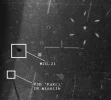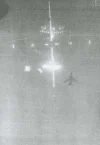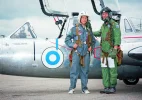Right - first up I can't really *prove* any of the stuff that follows,
although it is a composite of bits of news, opinion, or satirical
comment that I have come across at one time or another...
Let's just make it a fictionalised and condensed case study, using the
Hawk-to-T-45 transformation...
OK! Its nearly the 'eighties, and those TA-4s and T-2s aren't getting
any younger! We need a carrier capable trainer in a few years, so
lets get moving! Let's take a pretty good, capable, design to start
with, as we don't want to take any chances. The numbers look good on
the performance sheet, and the demonstration tours took it to the Test
Pilots and they seem to like it better than the competitor, so lets go
for the Hawk.
Right, now to think about getting it onto the carrier. How hard can
it be? The Brits haven't converted a land-based design *lately*, but
the US based partner company has a bit of knowhow in this area and had
a fairly long background of naval experience to draw upon...
First, it needs to be a bit heavier and toughened up to take the
loadings it will get during arrestment and catapult launch. Well, the
initial drawings and sums look OK! That's not too bad... So far so
good, lets do some details...
That undercarriage has to go, its too small and spindly for high sink
rates. OK, bigger main legs it is then. And the nose leg? Ah...
and that needs the twin wheels and catapult bar to go on it too? My
word, it's getting a bit chunky...
Well, we can make the front fuselage a bit deeper to make that new
nose gear fit inside, just like before!
Ummm - that airbrake *was* OK on the belly before (lets face it, they
spent enough time twiddling with it to get it right), but you can't
use it coming onto a carrier. And what about those strakes on the
edges of the well? - Doesn't it look like the arrestor wires are going
to crunch up a lot of them? Oh, never mind - lets just get rid of the
whole lot altogether, make the airbrake into smaller units and put one
on each side of the rear fuselage.
Cool! This is taking a bit longer than we thought, and the other Navy
planes are soaking up most of the money, but maybe we can buy some of
the regular model as a lead in, because that will be cheap enough to
pound the circuit without wasting all the money we spent on the
carrier stuff, and a fully carrier capable version for the heavy duty
bit. We can call the simple one the T-45B, and they can play with it
while we get the 'wet' one ready.
Look, having thought a bit about this, lets drop the T-45B. We can
build more T-45As or get the unit cost down somehow, and anyway, the
'B wasn't going to be as common as we thought, so its training
potential wasn't quite what we wanted...
Well, now we have flown it, we are in a bit of trouble! Those air
brakes give a big trim change when they pop out in certain
circumstances - maybe we need to work on that a bit - some strakes
ahead of the horizontal tail might tidy things up.
But there's worse! Sometimes the plane just won't stay pointed the
same way we want it to go! Oh no! The deeper front fuselage and
extra side area has mucked up the directional stability - especially
when the wheels are down (strange really - the other stuff seems to
happen when the wheels are up...) Ah well, ventral strakes are
usually a quick and cheap... oops - the arrestor wires! Forgot about
'banjoing'! Well, maybe we can make the fin even a bit taller still,
although that will need a bit more structure to hold it on without it
twisting anything or bending at the bottom...
Ah, we did that thing with the fin and we *still* need a ventral
strake, to keep it pointed the right way? OK, well, maybe just a
little one then...
My word - now the whole thing is a fair bit heavier than we thought!
And that extra bit of main leg length means that the previously superb
wing isn't quite so sweet closer to the stall - maybe we can put a
breaker strip or a fence on it, or something...
Boy, getting it onto the carrier is a bit of a hot experience! Can't
we get this overweight chunk to go a bit slower! Maybe we should
think about slats or leading edge droops or something to help us keep
down the approach speeds.
That's better. Its a pity that it takes so much power to hold this
thing up though - we seem to be eating engines! Ummm - the engine was
downrated a little, so that it would meet the requirements for TBO,
and bits of it were made of materials that were a bit thicker and
heavier than the one that was demonstrated, to give it a longer life,
so maybe they would let us..? Oh, they won't...
Isn't there another engine that would fit in the hole? Ah, great!
There is! But now we are looking at some more money and maybe some
compensation and contractual stuff to sort out before we back out on
the deal we cut all those years ago... And, of course, the new engine
might not be so trouble free once we get it on the airplane, and it
would be a whole new logistics and spares chain, but we *could* try it
and see if it whips the original supplier into line about putting the
thrust up and negotiating a modification to the original guarantees...
And so it goes on, until a fine Navalised airplane emerges from the
melee and matures in service...






